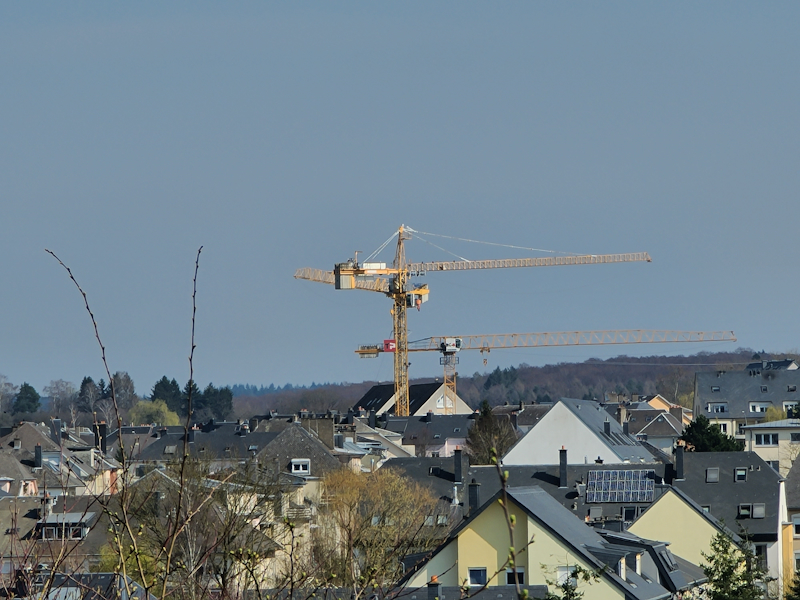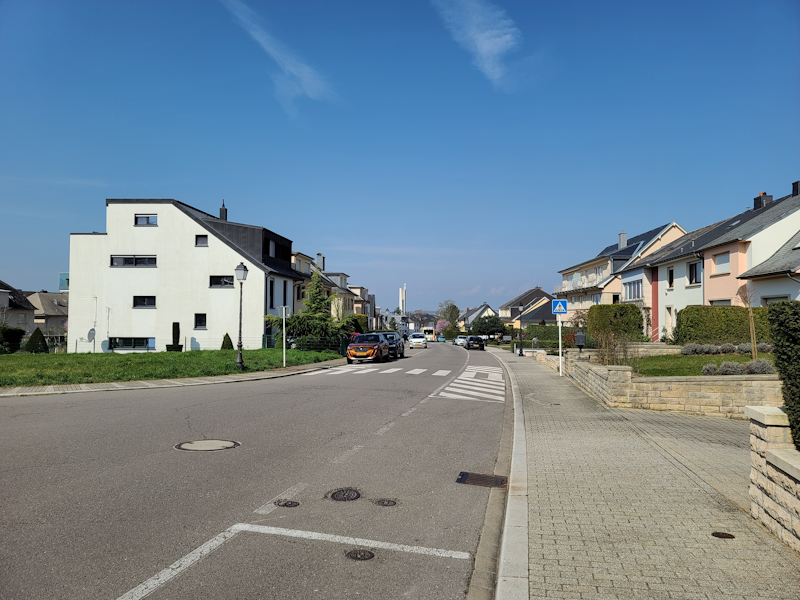The Samsung Galaxy S20+, S20 Ultra Exynos & Snapdragon Review: Megalomania Devices
by Andrei Frumusanu on April 3, 2020 9:30 AM ESTCamera: Daylight Evaluation: Far Sight
Naturally, the proof is in the pudding, and that’s where we’ll fully evaluate the S20 Ultras as well as the S20+. Last year we saw some larger camera quality differences between the Exynos and Snapdragon variants of the S10+; these differences slowly disappeared over the course of the year over numerous software updates, but there still remained some discrepancies here and there in terms of the software processing. This year, we’ll be putting the two S20 Ultras against each other in the same manner, and we also have the Exynos S20+ to check how that camera configuration compares.
I’ve noted that over the past years maybe I hadn’t been objective enough when it came to colour accuracy of the photo evaluations, so starting with the review today I want to do something else and add in another comparison point. The Fujifilm X-T30 with the standard 18-55mm kit lens will serve as a “reference” point in terms of the exposure and in particular the colour accuracy of the scenes – I particularly chose the Fuji because it had been praised as being amongst the best in the industry in this regard. The samples here are adjusted in terms of their exposure and dynamic range, but without any modification to the colour science.

[ Galaxy S20U - (S) ]
[ Galaxy S20U - (E) ]
[ Galaxy S20+ (E) ]
[ S10+ (S) ] - [ S10+ (E) ]
[ iPhone 11 Pro ] - [ Pixel 4 ]
[ Mate 30 Pro ] - [ P30 Pro ]
[ X-T30 ]
Diving right into the matter, let’s talk about the S20 Ultra’s zooming ability. Samsung here advertises up to 100x magnification, and I’ll pretty much discard this mode right out of the gate as being useless and a mere marketing gimmick. There’s essentially little to no advantage over a 30x magnification on the phone and it doesn’t even warrant samples as it just looks like a mess and no different than just magnifying the 30x shots digitally.
So, taking the 30x shots as the first comparison point, there’s only three phones in the line-up actually capable of such captures. Between the two S20 Ultra phones are very similar to each other, but there’s slight differences in terms of how they’re handling noise and sharpening. The Snapdragon unit has a bit more sharpening going for it but it’s hard to pick it as being outright superior. The S20+ is the only other phone capable to such magnification, and the difference to the S20 Ultras is quite large as there’s evidently a ton more pixilation and nowhere near the same spatial resolution – but that was to be expected.
At 10x magnification we again see the two S20 Ultra shots being similar in exposure, however there’s again differences in the detail. Here it’s more evident that the Snapdragon unit is using post-processed sharpening to the image, and there also appears to be some smearing of details as the Exynos unit does achieve to maintain some better textures on some elements.
Huawei’s P30 Pro and its own periscope telephoto module is the only unit that comes into play here as a competitor in terms of sharpness, but the S20 Ultras still beat it handily. The S20+ produces a useable result, but also lags behind the S20 Ultras – but is still far ahead of any other “conventional” zoom camera, with only the Pixel 4 competing in terms of result.
At 4x magnification which is the native level of the S20 Ultras, we again see the differences between the Snapdragon and Exynos units just pop right out at you, as the former’s sharpening is evident throughout the scene.
The S20+’s 3x result is the phone’s default mode when you tap on the telephoto zoom button when switching cameras, and the result does look respectable and is significantly more detailed than what you’d see from other 2-3x optical zoom modules, although the Mate 30 Pro’s 3x optics are much sharper, even if the sensor itself has some dynamic range issues.
At a 2x magnification, that’s where we see the S20 Ultra’s biggest weakness and problems. Samsung here is employing image fusion between the main and telephoto modules, using the sharper center image output of the telephoto module and merge it into the wider capture of the main unit. The problem here is that they’re doing this while the main module is at 12MP resolution, and the result is that the majority of the image looks like a pixelated mess as it has to do digital magnification on that 12MP image. It’s a massive disappointment and it’s here where the S20+’s dual-wide angle camera system comes to shine, as the 2x results is leaps and bounds better than on the S20 Ultras.
Not only are both S20 Ultras blurry here, but the Snapdragon S20 Ultra here goes haywire with the sharpening and the foreground vegetation is ridiculously over-processed, as if suffering from high image compression.

[ Galaxy S20U - (S) ]
[ Galaxy S20U - (E) ]
[ Galaxy S20+ (E) ]
[ Galaxy S10+ (S) ] - [ Galaxy S10+ (E) ]
[ iPhone 11 Pro ] - [ Pixel 4 ]
[ Mate 30 Pro ] - [ P30 Pro ]
[ X-T30 ]
In the next scene, again we see the two S20 Ultras dominate in terms of their sharpness and what they’re able to achieve, being far ahead of any other phone in terms of the achieved resolving power at high magnification.
The two Ultras again showcase big troubles at 2x magnification and are handily beat by every other phone in the line-up, even losing to last year’s S10.
Between the Snapdragon and Exynos S20U’s, the Qualcomm variant continues to showcase more post-processed sharpening throughout the scene on all camera modules. On both wide and ultra-wide shots, we see the Exynos able to retain better definition of textures in the brighter elements on the scene such as on the small and big concrete towers.

[ Galaxy S20U - (S) ]
[ Galaxy S20U - (E) ]
[ Galaxy S20+ (E) ]
[ Galaxy S10+ (S) ] - [ Galaxy S10+ (E) ]
[ iPhone 11 Pro ] - [ Pixel 4 ]
[ Mate 30 Pro ] - [ P30 Pro ]
[ X-T30 ]
The S20 Ultra’s telephotos are again quite incredible for a phone – far ahead of any other phone and handily beating my X-T30 on the regular kit lens. While the Snapdragon does pop out more and has more contrast in the details, it’s quite exaggerated and doesn’t feel as natural as the unsharpened results of the Exynos S20U.
On the main and ultra-wide, these differences continue. Vegetation might look more pronounced on the Snapdragon, but it loses out in texture retention to the Exynos throughout the scene.
This scene for some reason was very wrongly exposed on almost all the phones, with all of them getting a failing mark in that regard. Even though it’s in broad daylight, the S20 results barely have any elements in the upper 10-15% of the histogram in terms of exposure levels, the X-T30 better represents the scene as it was in reality.

[ Galaxy S20U - (S) ]
[ Galaxy S20U - (E) ]
[ Galaxy S20+ (E) ]
[ Galaxy S10+ (S) ] - [ Galaxy S10+ (E) ]
[ iPhone 11 Pro ] - [ Pixel 4 ]
[ Mate 30 Pro ] - [ P30 Pro ]
[ X-T30 ]
In the next shot there’s some issues that start arising for the S20+’s “telephoto” module, and that’s the optics. In this scene with an extremely bright backdrop against the sun with very high contrast due to the trees, we see very a very prominent haze around the high contrast elements. It’s as if the phone had a smudged lens, but it was actually clean. I noticed this happens in quite a for scenes for the S20+ and the only explanation I have is that it’s an optics issue with the lenses of this module.
This is also a good scene to start talking about the 108MP capture modes of the S20 Ultras. There’s a massive amount of detail here and these particular samples are around 50MB in size, as a warning before you open them.
Both phones are able to capture significantly more detail than in their default 12MP modes, however there a very stark differences between the Snapdragon and Exynos phones, with the latter being able to produce a much higher quality result with far more natural detail. I don’t know exactly what’s happening here, but it’s as if the Snapdragon picture was lower resolution and scaled up to 108MP, whereas the Exynos unit is closer to a native resolution shot.
Although there’s haze in parts of the shots, the 64MP shot of the S20+ here is doing a remarkable job in terms of keeping up with the 108MP cameras, and I’d even go so far to say that for large parts of the scene it’s actually able to resolve things with more spatial resolution than the S20 Ultra, particularly towards the edges of the scene where the Ultra just starts getting far too soft.

[ Galaxy S20U - (S) ]
[ Galaxy S20U - (E) ]
[ Galaxy S20+ (E) ]
[ Galaxy S10+ (S) ] - [ Galaxy S10+ (E) ]
[ iPhone 11 Pro ] - [ Pixel 4 ]
[ Mate 30 Pro ] - [ P30 Pro ]
[ X-T30 ]
This is another incredibly detail-rich scene, this time around with also more high dynamic range.
The S20 Ultras are quite different here in terms of their color renditions, with the Snapdragon being quite saturated. There’s also differences in exposure – although both phones were similar in their exposure time at 1/124 and 1/135th second, the Snapdragon chose ISO16 while the Exynos chose ISO50. There is some evident change in the HDR processing as the Exynos is able to better preserve the highlight of the sky and that part of the trees whereas it’s blown out on the Snapdragon.
The S20+ feels weird here on the main sensor as it produces a seemingly lower resolution image on the right side of the creek, with worse results than that of the S10 and other phones.

[ Galaxy S20U - (S) ]
[ Galaxy S20U - (E) ]
[ Galaxy S20+ (E) ]
[ Galaxy S10+ (S) ] - [ Galaxy S10+ (E) ]
[ iPhone 11 Pro ] - [ Pixel 4 ]
[ Mate 30 Pro ] - [ P30 Pro ]
[ X-T30 ]
The flower here is again a good example of the haze that’s present on the S20+’s 64MP lens module, again showing some weak optical characteristics.
When taking pictures of more close-up objects, the S20 Ultra’s huge sensor and shallower depth of field becomes more apparent as the background becomes significantly more out of focus and blurred out. The problem is that isn’t not so much a smooth bokeh more appears more as chromatic aberrations and quite a bit of a mess.
The phones are also having trouble with the exposure and HDR and highlights of the vegetation is far too bright, the Pixel 4 and iPhone 11 Pro are doing a much better job here.










137 Comments
View All Comments
Andrei Frumusanu - Friday, April 3, 2020 - link
No, there's no software application notion of displaying something at a given refresh rate - things just render as fast as possible unless. 3D games might have an FPS cap, but that's not refresh rate.FunBunny2 - Friday, April 3, 2020 - link
this is what I mean."If you can run a game at 100 frames per second, you may see a tangible benefit from playing it on a monitor that can refresh that many times per second. But if you’re watching a movie at a classic 24 FPS (frames per second), a higher refresh rate monitor won’t make any difference."
here: https://www.digitaltrends.com/computing/do-you-nee...
IOW, unless the processor sending either video or coded application images does so 120 per second, all the 120hz screen does is re-scan each image multiple times. how can the refresh rate create modified images, between those sent by the processor? or do 90/120hz screens do just that?
do you disagree with that author?
krazyfrog - Friday, April 3, 2020 - link
The screen refreshes at a set rate regardless of the content being sent to it. In this case, it always refreshes at 120Hz. If the content is in 24fps, each frame of the video persists for 5 refreshes of the display. To the eye, it looks no different than watching the same 24fps video on a 60Hz display.surt - Saturday, April 4, 2020 - link
Not true. It does not look the same to your eye, and the difference is the latency from the time that information is ready to display to the time it reaches your eye. The 120hz display will show that transition from e.g. the 23rd to the 24th frame significantly faster.FunBunny2 - Sunday, April 5, 2020 - link
" It does not look the same to your eye"that's a may be. years ago I worked in a manufacturing plant, no windows and only florescent lights. one of the guys I worked with wore glasses that looked like very weak sunglasses, but no prescription. I asked him about them and he said his eye doctor prescribed them for his constant headaches. turns out that some folks rectify the 60hz flash of florescent light, and it hurts. the same phenomenon would occur with monitors. if you're not among the rectifiers, it's hard to see how you would see different at 120hz.
surt - Sunday, April 5, 2020 - link
And yet, it's not hard to see at all. Response tests are undeniable. People's reactions are unquestionably faster on 120hz. Whether you notice the difference or not, it exists.surt - Saturday, April 4, 2020 - link
It matters to any game. If your game updates at 30fps, the 120hz display will get that information to your eye a fraction faster than the 60hz display, because the 'time to next frame' + 'time to display next frame' is always smaller on the 120hz.eastcoast_pete - Friday, April 3, 2020 - link
Great review, thanks Andrei! Question: just how much power draw does the 5G modem add, especially the mm ones for us in the US? Along those lines, can the 5G function disabled in software, so not just deselected, but actually shut off? I imagine that the phone hunting for mm connectivity when it's not there could eat quite a bit of battery life.Andrei Frumusanu - Friday, April 3, 2020 - link
I don't even have 5G coverage here so I wouldn't know!Yes, 5G can be disabled in the options. I would assume that actually shuts off the extra RF. Similarly, I don't know how the mmWave antenna power management works.
eastcoast_pete - Friday, April 3, 2020 - link
Thanks for the reply! mm 5G coverage is supposedly "available" in some places here in the US, but I don't believe the carriers here have set up anywhere near enough cells for it to be viable. Plus, even if I'd get Gb download rates, they still have caps on their plans, unless one shells out for the premium unlimited ones. And those make the 20 Ultra's price tag look like a bargain (: